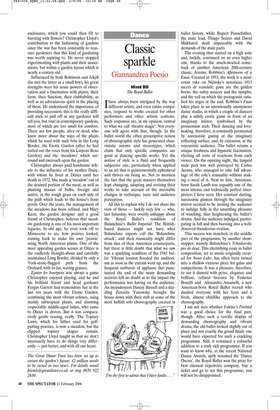Classic sparkle
Giannandrea Poesio
Mixed Bill The Royal Ballet Ihave always been intrigued by the way different artists, and even entire companies, respond to works created for other performers and other artistic contexts. Such responses are, in my opinion, central to what we call ‘theatre magic’. Not everyone will agree with that, though. In the ballet world the often prescriptive notion of choreographic style has generated chauvinistic axioms and stereotypes, which claim that only specific companies are good at dancing specific works. Yet the notion of style is a fluid and frequently subjective one, particularly when applied to an art that is quintessentially ephemeral and thrives on being so. Not to mention the fact that the great masters themselves kept changing, adapting and revising their works to take account of the inevitable changes in technique, taste and audience perception.
All this to explain why I do not share the view of those — luckily very few — who, last Saturday, were overtly unhappy about the Royal Ballet’s rendition of Balanchine’s Ballet Imperial. The Britishbased dancers might not have what Balanchine experts call the ‘Balanchine attack’, and their musicality might differ from that of their American counterparts, but there is little doubt that what we saw was a sparkling rendition of the 1941 ballet. Vibrant tension flooded the auditorium as soon as the curtain went up, and the frequent outbursts of applause that punctuated the end of the many demanding sections left no doubt as to the impact the performance was having on the audience. An incandescent Darcey Bussell and a dazzling Zenaida Yanowsky brought the house down with their stab at some of the most hellish solo choreography created in ballet history, while Rupert Pennefather, the male lead, Thiago Soares and David Makhateli dealt impeccably with the demands of the male parts.
The evening thus started on a high note and, luckily, continued on an even higher one, thanks to the much-awaited comeback of another American 20th-century classic, Jerome Robbins’s Afternoon of a Faun. Created in 1953, the work is a modernist take on Nijinsky’s notorious 1913 succès de scandale; gone are the golden horns, the sultry scenery and the nymphs, and the veil on which the protagonist satisfied his urges at the end. Robbins’s Faun takes place in an intentionally anonymous dance studio, in which a couple of dancers play a subtly erotic game in front of an imaginary mirror, symbolised by the proscenium arch. Their dancing and lovemaking, therefore, is constantly permeated by narcissistic gazing at the imaginary reflecting surface, and, by extension, at the voyeuristic audience. The ballet retains a unique freshness and hypnotic fascination, eliciting all sorts of reactions from each viewer. On the opening night, the languid male part was well portrayed by Carlos Acosta, who managed to take full advantage of the role’s sensuality without making a meal of it. Next to him, Americanborn Sarah Lamb was arguably one of the most intense and technically perfect interpreters I have seen. Her constant darting, narcissistic glances through the imaginary mirror seemed to be inviting the audience to indulge fully in the unsettling pleasure of watching, thus heightening the ballet’s drama. And the audience indulged, participating in full and then bursting into a welldeserved thunderous ovation.
This success was matched, in the middle part of the programme, by another showstopper, namely Balanchine’s Tchaikovsky pas de deux. This electrifying essay in ballet composition, set to music originally created for Swan Lake, has often been turned into a shallow virtuoso piece for galas and competitions. It was a pleasure, therefore, to see it danced with poise, elegance and brilliant, refined bravura by Federico Bonelli and Alexandra Ansanelli, a new American-born Royal Ballet recruit who dazzled everyone with her feats and a fresh, almost childlike approach to the choreography.
I am not sure whether Fokine’s Firebird was a good choice for the final part, though. After such a terrific display of demanding choreography and vibrant drama, the old ballet looked slightly out of place and not exactly the grand finale one would have expected for such a crackling programme. Still, it remained a colourful addition to a truly rich programme. If you want to know why, at the recent National Dance Awards, aptly renamed the ‘Dance Oscars’, the Royal Ballet won the prize for best classical repertoire company, buy a ticket and go to see this programme; you will not be disappointed.














































 Previous page
Previous page